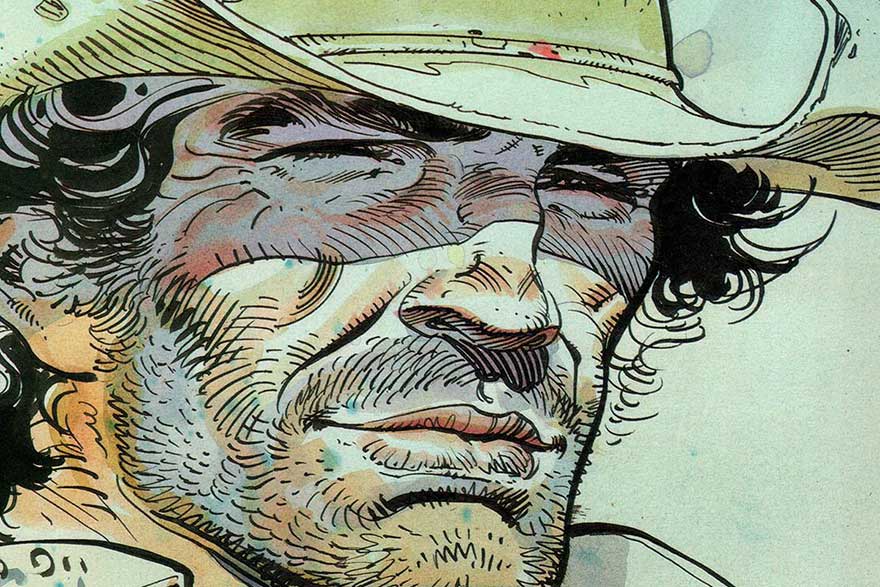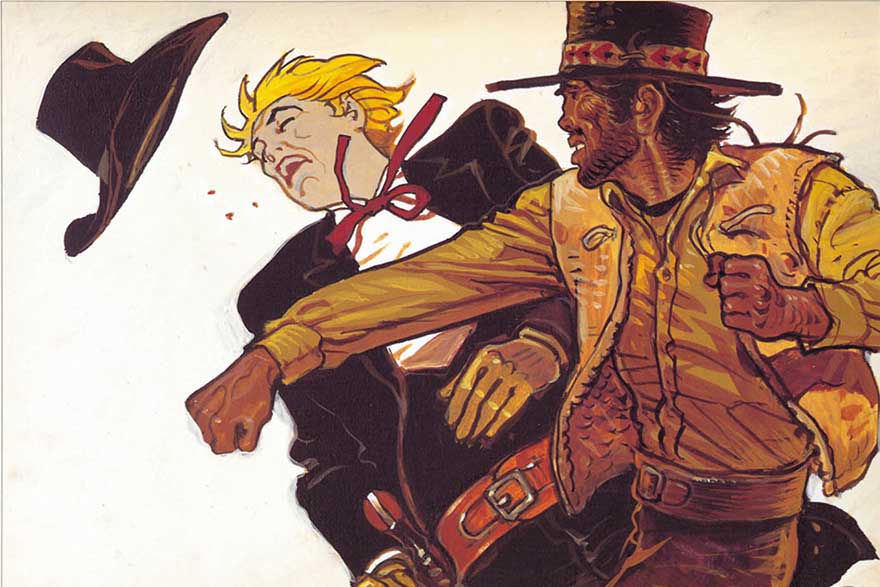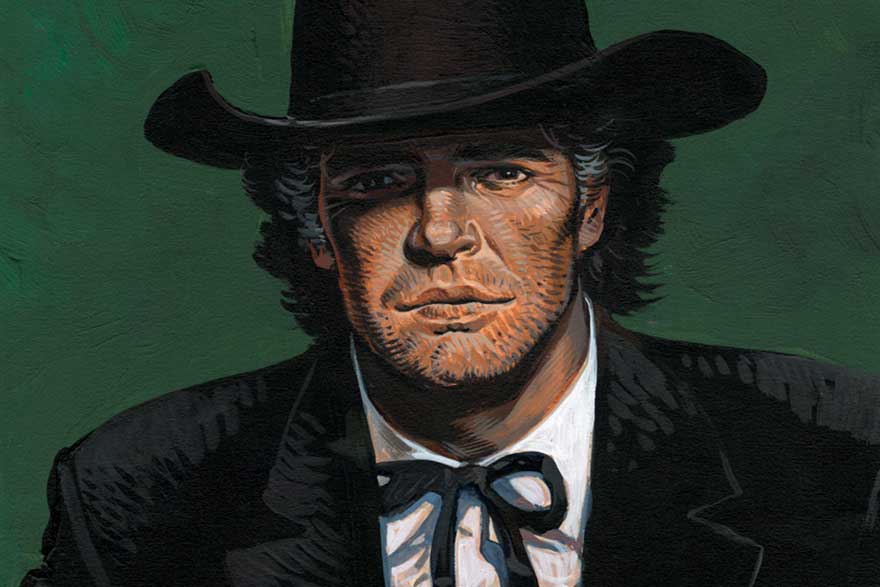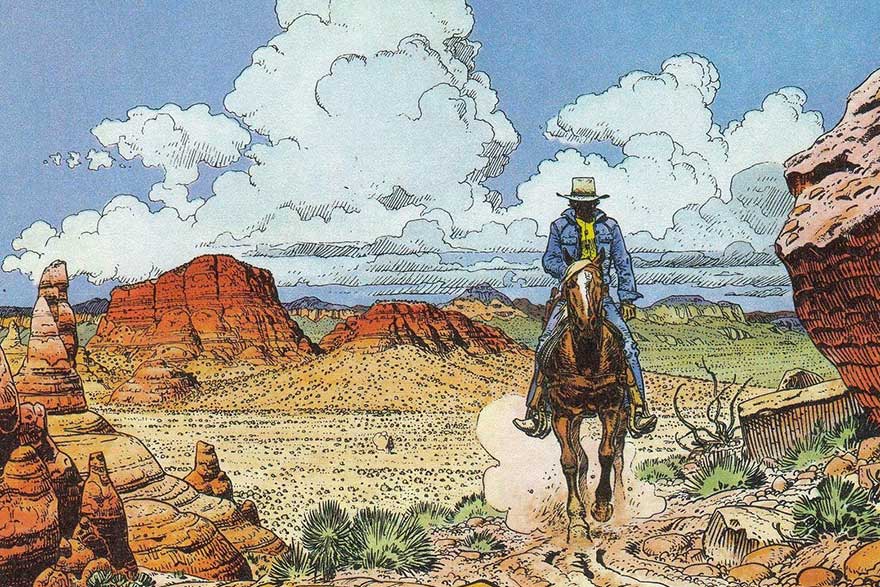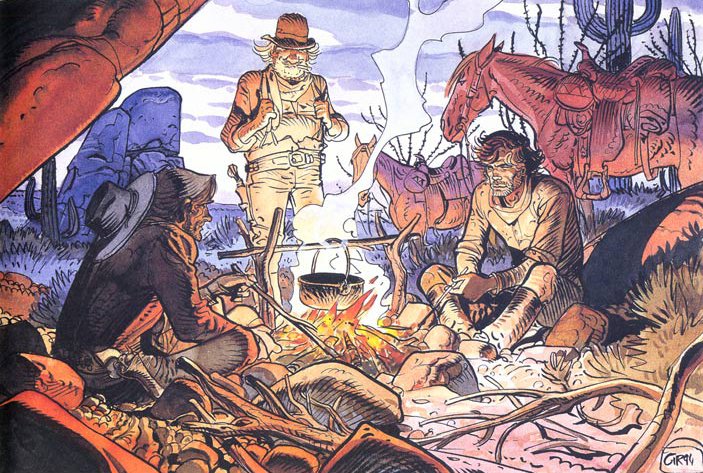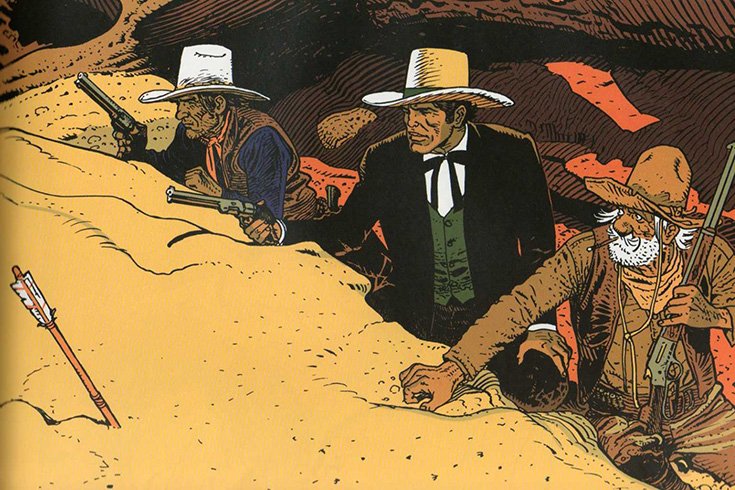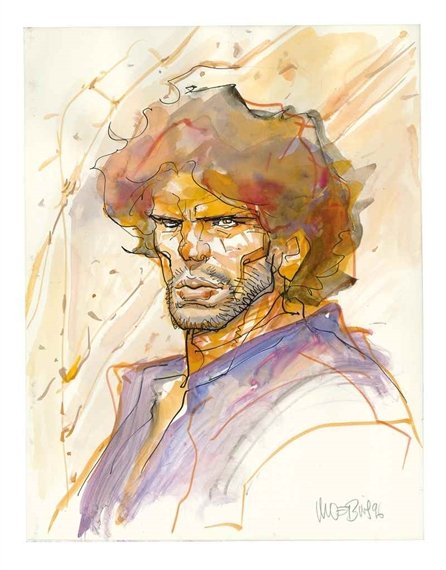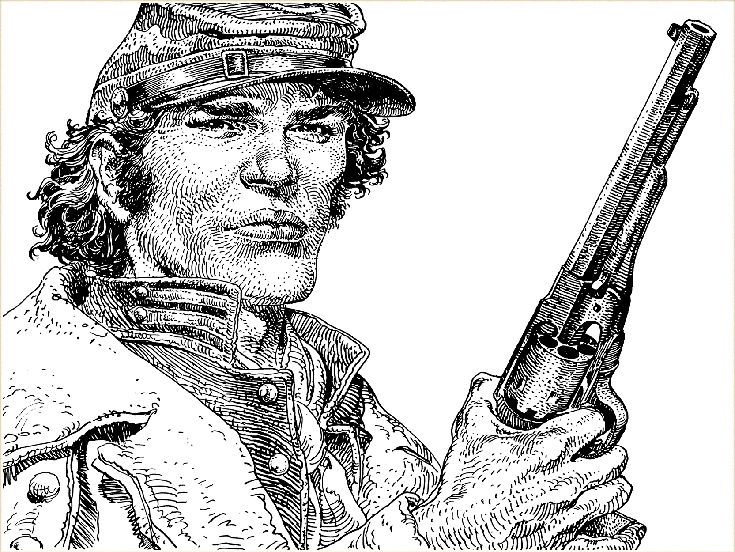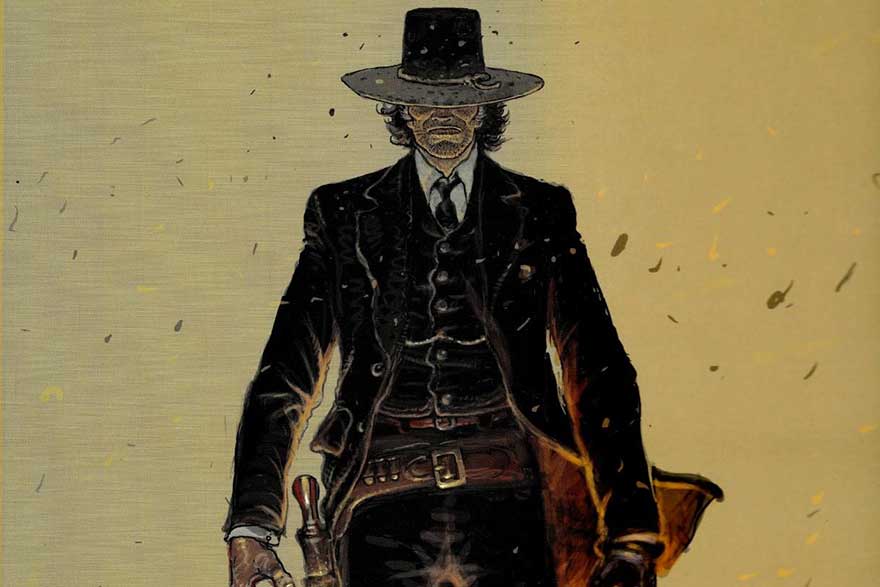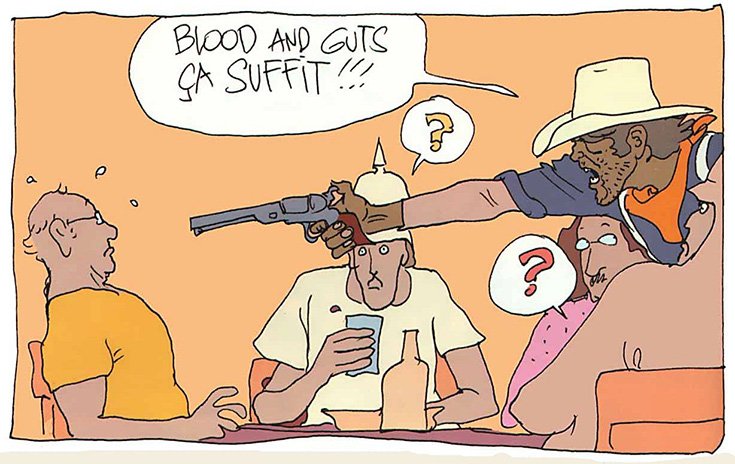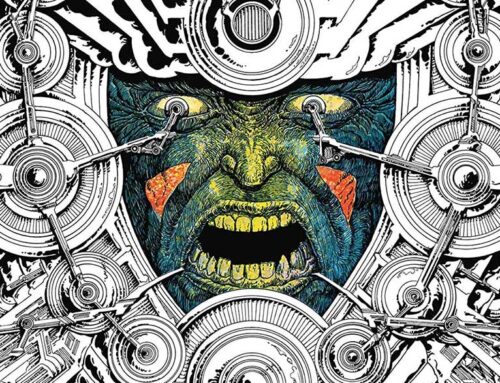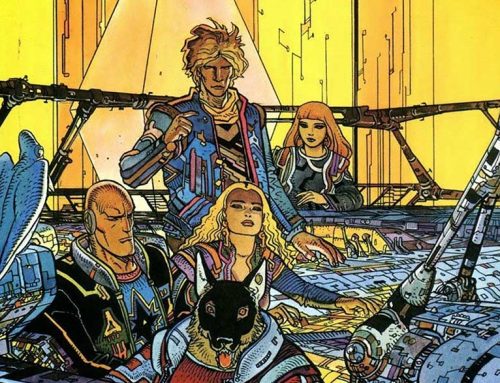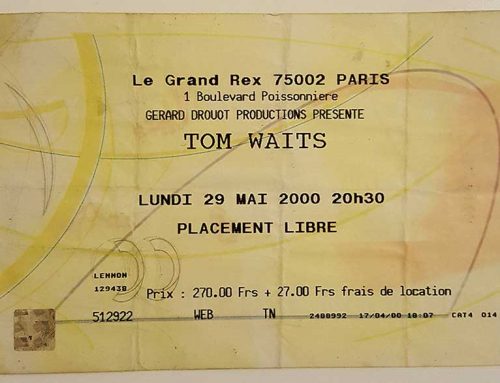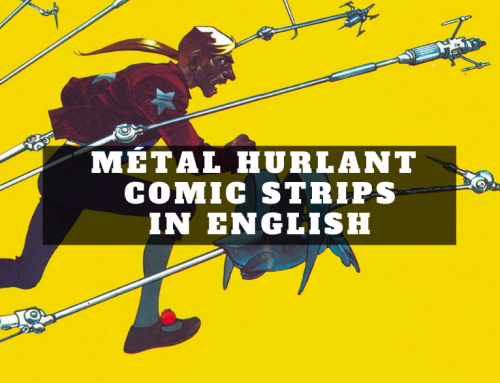The legendary French comics artist Jean Giraud (1938-2012) was better known as Moebius, and under that enigmatic alter-ego he bent minds and burned retinas for nearly half a century. His classic strips like Arzach, The Incal and The Edena Cycle were beautifully illustrated and relentlessly idiosyncratic works that continue to be discussed by his many fans in hushed, reverential tones. His influence can be found in graphic design, movies, novels and even the catwalks of the world’s fashion capitals. He’s an undisputed comics industry A-lister who managed to get himself admitted into this very select club despite already being a member.
Giraud had already made his name as a successful cartoonist long before Moebius revolutionised comics in the 1970s. Under another pseudonym – ‘Gir’ – he produced comics so vastly different from the work of Moebius that they could almost have been created by a different artist. Where Moebius’ illustrations were loose and spontaneous, Gir’s were tight and meticulously rendered. While Moebius sculpted hitherto unseen vistas with his seemingly limitless imagination, Gir anchored his stories to a gritty, authentic depiction of the past. And just as Moebius explored personal, esoteric themes by subverting the visual language of science-fiction and fantasy, Gir produced a series of classic, page-turning adventure yarns set in the American Old West. By the late-1960s he was widely recognised as one of the Western genre’s finest comic artists, an achievement made possible thanks to a young, undisciplined cavalry officer that went by the name of Mike S. Blueberry.
For the uninitiated, Lieutenant Blueberry was a comic book Spaghetti Western – a Soufflé Western, if you will – that, like its cinematic counterpart, reinvigorated that most American of genres. Like the Dollars Trilogy of Sergio Leone, it breathed new life into familiar tropes by presenting a gritty, revisionist depiction of the Old West that was shot through with European sensibilities. Created in 1963 by Giraud and the veteran comics writer Jean-Michel Charlier (1924-1989), Blueberry made his debut in the classic French anthology title Pilote and his adventures were subsequently chronicled in a series of 28 albums, from 1963s Fort Navajo to 2005’s Dust. Beside the main series, the character appeared in two significant spin-off titles – Young Blueberry and Marshall Blueberry – that featured Giraud and Charlier working with other talented writers including François Corteggiani, William Vance and Colin Wilson.
In Giraud’s native France, Blueberry has remained his most popular series, stubbornly outselling the titles penned by his more illustrious alter-ego. In fact, the character’s appeal went beyond the traditional bande dessinées audience, with later volumes serialised in the daily newspaper Le Monde and in the weekly news magazine L’Express.
In contrast, for many Anglo-American comic fans, Blueberry represents a weird, incongruous entry in Moebius’ otherwise exemplary oeuvre. They dismiss the strip as a generic prelude to Giraud’s more ambitious, more interesting work. While Moebius’s art was characterised by vivid imagery and dizzying inventiveness, Gir’s art on Blueberry represented a workmanlike adherence to traditional storytelling techniques. With Blueberry, Giraud learnt his craft; as Moebius, he evolved into an artist.
So, does Blueberry deserve to be anything more than a footnote in a great man’s career? Is it just an anomaly whose continued popularity amongst the French is not dissimilar to their inexplicable fondness for Jerry Lewis, cheese and bureaucracy?
As another much-maligned Western icon might have put it: ‘The Hell it is.’
Blueberry made his debut in 1963, the same year as JFK got shot, Profumo got busted and The Amazing Spider-Man first hit the spinner-racks. Charlier was an established comics veteran, a ‘founding father’ of the Silver Age of Franco-Belgian comics, while Giraud was just a young artist struggling to make a name for himself. Already a precocious talent, he’d made his professional debut at the sickeningly tender age of 17, illustrating The Adventure of Frank and Jeremie for Far West magazine [1956]. Over the next few years he worked on various titles like Ames Vaillantes and Coeur Vaillantes, spent a year in the army, then served an apprenticeship under Europe’s premier illustrator of Western comics, Joseph ‘Jije’ Gillian.
While Giraud worked mainly in Westerns, Charlier, by contrast, ‘never felt much empathy for that genre’, and when Giraud pitched a new idea for a cowboy strip to him in 1961 he politely declined. A reporting assignment to California’s Mojave Desert, though, changed Charlier’s mind. As with Krazy Kat’s George Herriman 50 years earlier, the rugged, otherworldly ambience of the American West inspired him artistically: ‘I returned to France with the overpowering and almost irresistible urge to write a Western.’ Charlier wanted to serialise the strip in Pilote, the comic magazine he’d co-founded in 1959, and started to look for a suitable artist. He first turned to Jije, but he was already producing western strip Jerry Spring for Pilote’s Belgian rival, Spirou. To avoid a conflict of interest, he put Charlier in touch with his former apprentice, Giraud.
Right from the start, Giraud and Charlier made it clear that they weren’t going to adhere to the traditional Western comics template. When Blueberry made his debut as a supporting character in Fort Navajo he represented a new kind of comic-book hero: ‘I did not want the type of fearless lawman like […] The Lone Ranger or Jerry Spring as a hero,’ said Charlier. ‘That kind of character had, in my opinion, been done to death. That is why I made Blueberry the very opposite of these kind of hero archetypes. He is dirty, ugly and bad-tempered. He drinks, smokes, gambles and swears. And also, to make him even more different with the other characters, who are more the wandering kind, I decided to make him a soldier. But again, I didn’t want him to be a good little soldier who follows orders and does what he’s instructed to do. Blueberry is the exact opposite of that: he is undisciplined, cynical and hates authority.’
European readers soon warmed to this hard-drinking, chain-smoking gambler who looked a lot like French movie star Jean-Paul Belmondo. The strip’s innovations didn’t end with the protagonist’s colourful traits and rebellious attitude, however. As the series progressed, something that continues to distinguish Blueberry from other comic titles – Western or otherwise – was the fact its protagonist was subject to a force most comic-book characters remain blissfully immune to. That force was time. Over the course of the series, just as the meticulously embellished backdrops evolved to reflect the unfolding history of the American West, Gir’s depiction of Blueberry changed. His youthful good looks faded, his temples turned grey and his face became increasingly weather-beaten: life was taking its toll on the on the character. The rebellious young soldier became a jaded Marshall of a frontier town, a fugitive on the run, an honorary Navajo ally and – in later volumes – a retired card-shark. Jean-Paul Belmondo had clearly let himself go.
The impact of time on Blueberry was more than just cosmetic, however. With the classic ‘Confederate Gold’ story arc that began with 1970’s Chihuahua Pearl, Giraud and Charlier put their hero through the wringer, pitting him against forces more complex and powerful than anything he’d previously encountered. Inspired by the same historical events that served as a springboard for Sergio Leone’s classic movie The Good, The Bad and The Ugly, Blueberry was sent on a secret mission to retrieve a missing cache of Confederate treasure. Not only did he have to outwit the typical array of scheming villains, ruthless bandits and mean, vicious sons-of-bitches, but he found himself betrayed, framed and double-crossed by his own side. Tortured and left to rot in a brutal military prison, he became bitterly disillusioned with everything he once believed in. Blueberry’s youthful idealism had been crushed as he went from being a rebel to a bitter cynic.
These days, it’s almost de rigueur to put comic book heroes through a seasonal upheaval. Even when they lose their lives it usually doesn’t last for long. It’s a medium that relies not on change but on what the late Stan Lee once called ‘the illusion of change.’ Superman, Batman, Captain America, and The Hulk were never going to stay dead for long, while so many of Marvel’s X-Men have returned from the grave – in some cases, repeatedly – that the already convoluted mutant mythology now includes a set of ‘Resurrection Protocols’. With Blueberry, though, Charlier and Giraud attempted something more substantial: lasting, irrevocable change. In Charlier’s words, he became ‘a pawn who is caught in a cruel web of fate from which he cannot extricate himself, in spite of all his best efforts. Yes, he does manage to free himself occasionally, in this or that episode, but it is always temporary because, ultimately, Blueberry cannot escape his destiny. Little by little, he becomes even more trapped, and that is the tragedy of his life.’ An adventure strip had turned into a Greek Tragedy that was being played out against the backdrop of the American West. The rebellious hero had evolved into a tragic anti-hero.
With so much character and narrative depth, it may be surprising that Blueberry isn’t more popular amongst Anglo-American readers. For many years, and due to various rights issues, English translations of Moebius’ sci-fi comics have been notoriously thin on the ground. Compared to his Blueberry work, however, they’re positively ubiquitous. There hasn’t been an official English translation of Blueberry material since the mid-1990s, and when a movie adaptation was released in 2004 it went straight-to-DVD in the US and had its title changed to Renegade, which is always a bad sign.
Maybe it’s because Anglo-American genre fans aren’t as partial to Westerns as their French counterparts (although that hasn’t done The Mandalorian any harm), or maybe it’s because Blueberry’s Old West isn’t as eye-poppingly purty as the stomping grounds of Arzach, John DiFool and Major Grubert. There is – it must be said – a conspicuous lack of groovy crystals, funky space flares and transcendental cosmic nookie in the world of Lieutenant Blueberry. Blueberry is therefore dismissed as Giraud’s comics apprenticeship, a larval stage when he learnt how to master the tools of his trade before his explosive mutation into Moebius. Just as the maverick filmmaker Robert Altman served his apprenticeship on hokey TV westerns like Bonanza before making seminal movies like M*A*S*H and Nashville, Giraud cut his artistic teeth on Blueberry before turning his attention to far more important things. It’s a neat, linear career trajectory that seems to make sense. It also doesn’t tally up with the facts.
Giraud’s first piece of work as ‘Moebius’ was a Harvey Kurtzman-inspired strip that was published in the satirical magazine Hara-Kiri (the forerunner of Charlie Hebdo) in 1963, the year Lieutenant Blueberry made his debut. Furthermore, the rise of Moebius – and even the death of Charlier – wasn’t enough to stop Giraud from continuing to produce Blueberry strips, albeit on a more irregular basis. The relationship between the artist’s two creative personas was more than just a straightforward, caterpillar-to-butterfly mutation: Gir and Moebius coexisted in time, sometimes influencing each other, at other times striving to be distinct.
To be fair to the detractors, from a modern perspective the early Blueberry strips do look quite dated. Giraud’s artwork was still influenced by Jije’s, so much so that when his former mentor did some fill-in work on the fourth Blueberry story, The Lost Rider, it was hard to tell the difference. Possibly spurred on by this, Giraud’s style changed with the next album [‘The Trail of the Navajos’] into something more distinct. It wouldn’t be the last time his artwork would evolve on Blueberry.
With each passing volume, Giraud’s craftsmanship and storytelling prowess increased. As Charlier immersed himself in the history and mythology of the American West, Giraud rigorously scrutinised reams of visual reference material to ensure that his depiction of this era would be authentic. During the seminal ‘Confederate Gold’ storyline, Giraud’s art evolved yet again, as he tried to visually capture ‘the degradation of the mythical hero, his tiredness, his anger.’ His linework seemed to evolve with each passing volume: ‘I began to make full use of all the skills with the brush that I’d learned throughout my career up to that point. I felt that I was comfortable enough with my technique to start experimenting and pushing myself towards new limits.’
Apart from the demands of the story, the underlying reason for all this accelerated growth was the parallel rise of Moebius. There was a period when the Gir and Moebius personas seemed to be struggling to assert control over the art of Blueberry. 1975’s Angel Face – the first Blueberry volume to appear after the launch of Metal Hurlant magazine – featured looser linework and a more innovative panel structure. The next album, by contrast – 1979’s Broken Nose – saw Gir boldly reassert himself with linework so sharp he might just as well have drawn it with a razor.
Over time, Gir and Moebius seemed to have reached some kind of gentlemen’s agreement. The art on some of the later Blueberry volumes – 1995’s ‘Arizona Love’, for instance – feature an ornate, decorative flair that was clearly influenced by Moebius. While the Blueberry stories continue to be overlooked by many of Moebius’ Anglo-American comics fans, Giraud seemed to regard his two career strands as equally important: ‘To draw Blueberry requires an extraordinary level of graphic discipline. It’s a little like the difference between Delacroix and Picasso. To draw like Delacroix requires the mastery of an astounding number of techniques. To draw like Picasso requires “only” a certain kind of vision. It may be more difficult to achieve, but once you have it, it’s a type of activity that can accommodate any lifestyle. On the other hand, drawing like Delacroix – if you don’t feel well, or if you haven’t practised for many months – is extremely difficult.’
This reconciliation of his two personas was made explicit in Moebius’ final project, his six volume Inside Moebius series. An autobiographical stream-of-consciousness sketchbook reflecting on the creative process, it features the author as protagonist interacting with his younger self as well as some of his most memorable characters. These include Major Grubert from The Airtight Garage, Stel and Atan from his Edena Cycle, Arzach, and a haggard, tough-talking cavalry officer with no time for navel-gazing: “Bag this lame story right now and get busy with my script!” he snarls.
He’s older, but he still looks a lot like Jean-Paul Belmondo.

